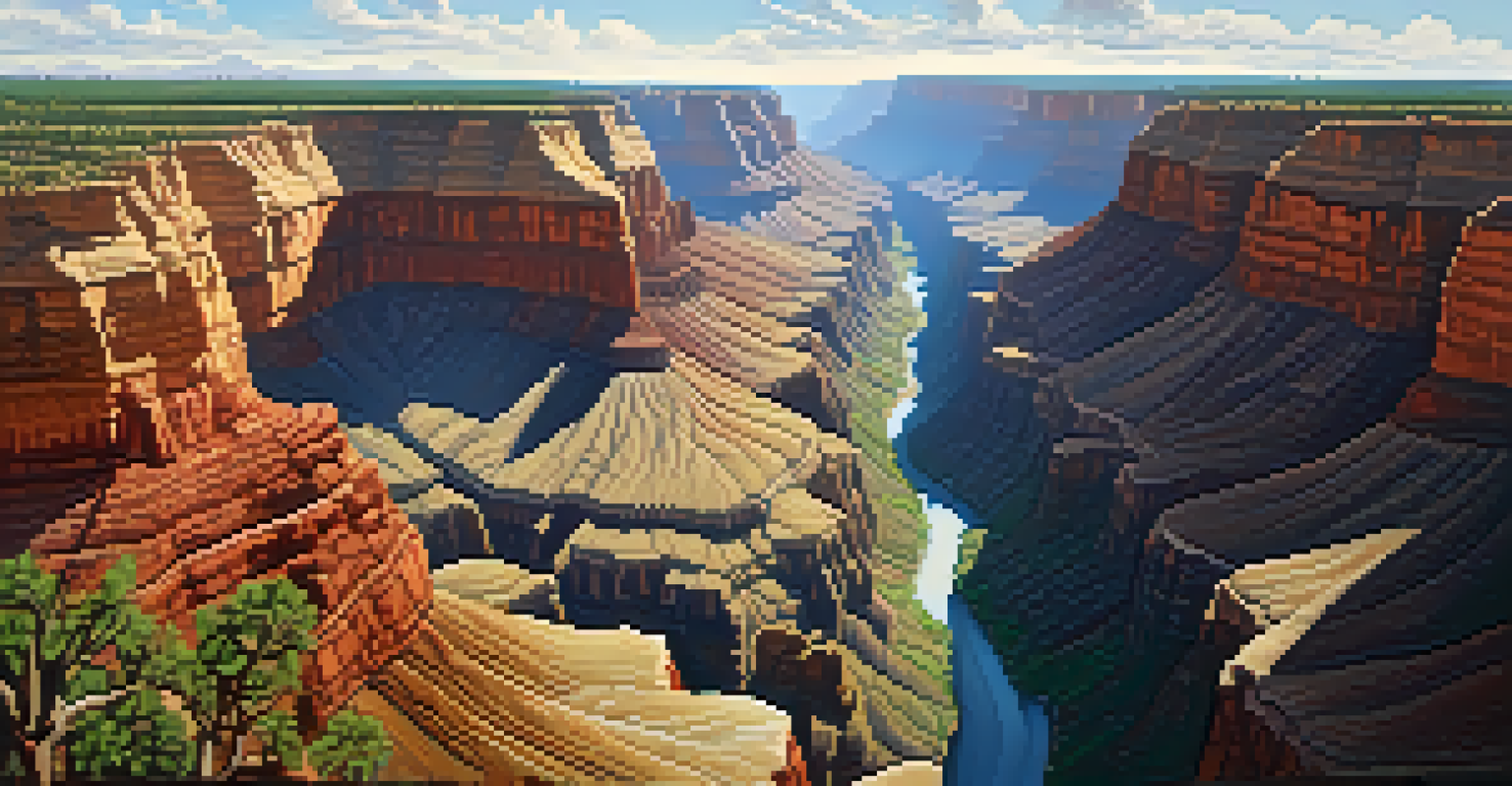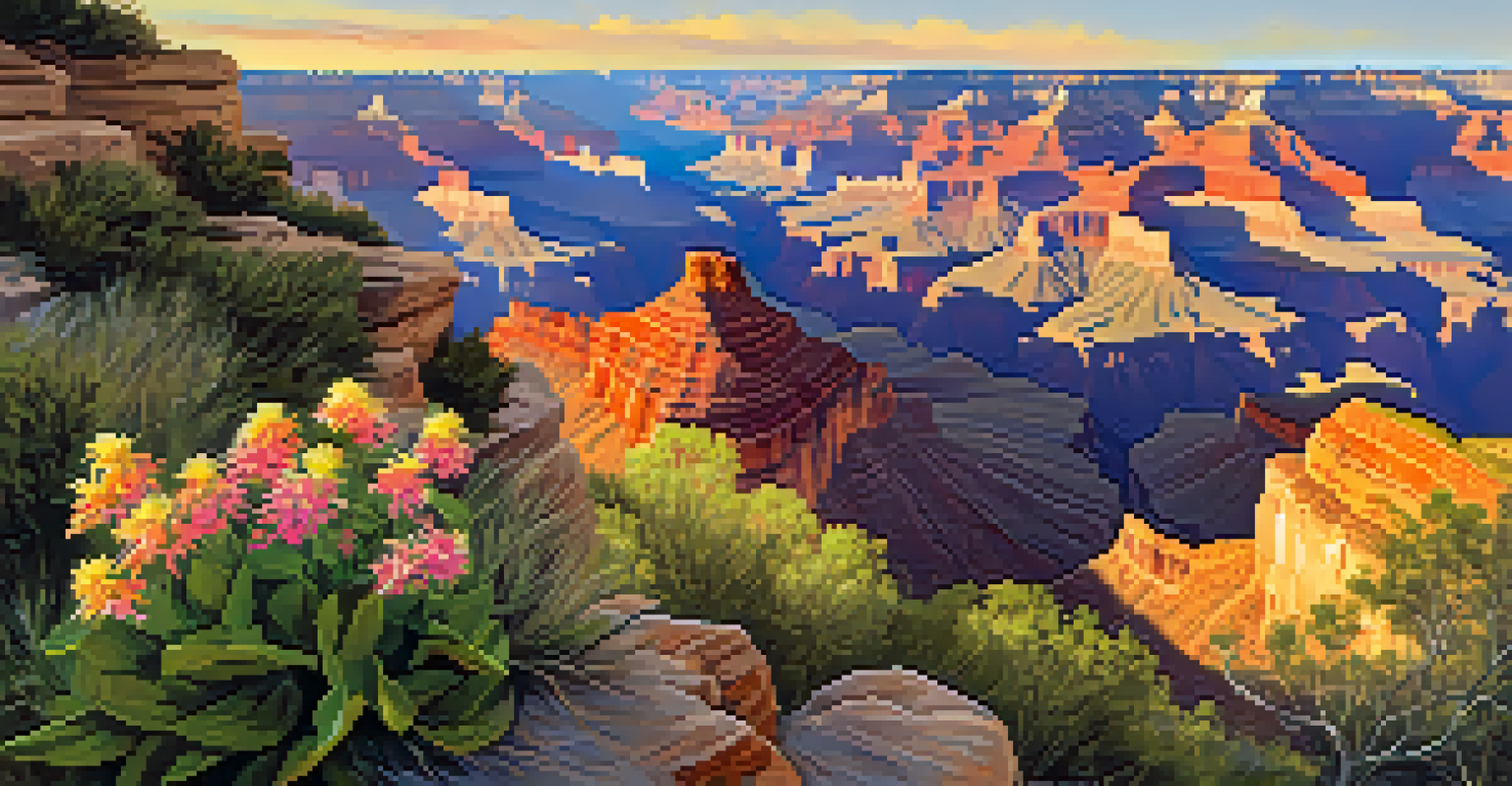Exploring the Wonders of the Grand Canyon as a Heritage Site

The Grand Canyon: A Natural Marvel of the World
The Grand Canyon is not just a breathtaking sight; it’s a geological masterpiece. Carved over millions of years by the Colorado River, this natural wonder showcases dramatic cliffs and vibrant colors that change with the light. Visitors often find themselves in awe of the vastness, with the canyon stretching 277 miles long and reaching depths of over a mile.
The Grand Canyon is a natural wonder that inspires awe and reverence, reminding us of the power of nature and the beauty of our planet.
The layers of rock found in the canyon tell a story of Earth’s history, offering insights into different geological periods. Each stratum, from the ancient Vishnu Schist to the relatively young Kaibab Limestone, reveals the processes that shaped our planet. For anyone curious about geology, the Grand Canyon is a living textbook, waiting to be explored.
Beyond its physical beauty, the Grand Canyon serves as a reminder of the earth's enduring power and resilience. It invites visitors to reflect on the forces of nature that have shaped not just the landscape but also our understanding of the world around us.
Cultural Significance of the Grand Canyon
The Grand Canyon is steeped in cultural significance for numerous Native American tribes. For over a thousand years, tribes like the Havasupai, Hopi, and Navajo have called this region home, weaving their traditions and spiritual beliefs into the very fabric of the canyon. The area is rich in sacred sites, and many tribes consider the canyon a living entity.

Their stories, passed down through generations, speak of creation, survival, and the deep connection between the land and its people. The Grand Canyon is more than a physical space; it’s a tapestry of history, spirituality, and identity for these communities. Engaging with these narratives offers visitors a deeper appreciation of the canyon's significance.
Grand Canyon's Geological History
The Grand Canyon is a geological marvel, revealing Earth's history through its layered rock formations and the processes that shaped them.
Furthermore, the preservation of these cultural identities is vital for future generations. As tourism increases, it’s essential to respect and honor the traditions and histories of the tribes that have long resided in this majestic landscape.
Biodiversity and Ecosystems of the Canyon
The Grand Canyon is home to a remarkable array of biodiversity, housing over 1,500 plant species and 447 animal species. From the lush vegetation along the Colorado River to the arid desert surroundings, the canyon's varied ecosystems create a unique habitat for wildlife. This diversity is not only fascinating but crucial for maintaining ecological balance.
The preservation of the Grand Canyon is not just a responsibility; it's an obligation to future generations to ensure they can experience its grandeur.
Each layer of the canyon supports different types of flora and fauna, showcasing how elevation and climate influence life. For instance, as you ascend from the river to the rim, you’ll encounter everything from cacti to ponderosa pines. This gradient of habitats provides opportunities for nature enthusiasts and researchers to study adaptations and interactions within ecosystems.
Moreover, the ongoing conservation efforts aim to protect this biodiversity against threats like invasive species and climate change. By understanding the interdependence of these ecosystems, we can better appreciate the Grand Canyon's role in sustaining both wildlife and the natural world.
Recreational Activities in the Grand Canyon
The Grand Canyon offers a playground for adventure seekers and nature lovers alike. From hiking the iconic Bright Angel Trail to rafting down the Colorado River, there’s something for everyone to enjoy. These activities not only provide excitement but also connect visitors with the canyon’s stunning landscapes in a personal way.
For those who prefer a more leisurely experience, there are scenic viewpoints and guided tours that highlight the canyon’s beauty without the sweat. The South Rim is particularly popular, featuring accessible paths and breathtaking vistas that can be enjoyed by all ages. Watching the sunrise or sunset from these viewpoints is an unforgettable experience, painting the canyon in hues of orange and pink.
Cultural Heritage of Native Tribes
For many Native American tribes, the Grand Canyon embodies a rich tapestry of cultural significance, spirituality, and identity.
Additionally, the Grand Canyon National Park offers various educational programs and ranger-led activities that enhance the visitor experience. These initiatives aim to inspire a love for nature and foster a sense of stewardship for this incredible heritage site.
Conservation Efforts at the Grand Canyon
Conservation of the Grand Canyon is crucial to preserve its natural and cultural resources for future generations. Various organizations, including the National Park Service, work tirelessly to protect the park's ecosystems, wildlife, and historical significance. These efforts ensure that the canyon remains a vibrant destination for both visitors and wildlife alike.
Challenges such as climate change, invasive species, and increased tourism necessitate proactive management strategies. Innovative approaches, like restoring native plant species and monitoring wildlife populations, are implemented to maintain the delicate balance of the canyon’s ecosystems. Additionally, public awareness campaigns help educate visitors about their role in conservation.
Engaging the local community and Native American tribes in conservation efforts is also essential. Their traditional knowledge and practices can offer valuable insights into sustainable management, ensuring that the Grand Canyon remains a cherished heritage site for generations to come.
Planning Your Visit to the Grand Canyon
Planning a visit to the Grand Canyon can feel overwhelming, but with a little preparation, it can be an unforgettable experience. Start by deciding which rim to visit—each offers unique perspectives and activities. The South Rim is the most accessible and popular, while the North Rim provides a quieter, more secluded atmosphere.
Consider the time of year you plan to visit, as each season brings its own charm. Spring and fall offer mild weather and fewer crowds, while summer is bustling with activity. Winter, although cold, transforms the canyon into a serene wonderland, perfect for those who enjoy solitude and snowy landscapes.
Biodiversity and Conservation Efforts
The Grand Canyon supports diverse ecosystems, and ongoing conservation efforts are essential to protect its wildlife and natural resources.
Lastly, don’t forget to explore the various accommodations available, from campgrounds to lodges. Booking in advance is essential, especially during peak seasons. With a bit of planning, you can make the most of your adventure in this iconic heritage site.
The Future of the Grand Canyon as a Heritage Site
The future of the Grand Canyon as a heritage site hangs in a delicate balance, influenced by environmental, social, and economic factors. As awareness about climate change grows, the importance of protecting this natural wonder becomes increasingly urgent. The canyon faces threats from increased visitation and potential development, making conservation efforts more critical than ever.
Engaging local communities and stakeholders in decision-making processes can help ensure that the Grand Canyon remains protected. Initiatives that prioritize sustainable tourism and respect for Native American traditions are vital for preserving its integrity. The goal is to foster a deep appreciation for the canyon while minimizing the impact of human activity.

Ultimately, the Grand Canyon represents not just a destination but a legacy. By advocating for its preservation, we can ensure that this magnificent heritage site continues to inspire awe and wonder for generations to come.